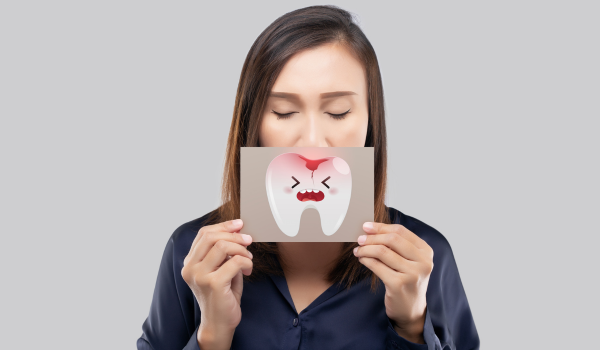.png)
Gingivitis is the earliest and mildest form of gum disease. If left untreated, it can progress into more severe gum diseases, potentially causing tooth loss and other oral health complications. Fortunately, gingivitis is largely preventable with the right daily habits. By adopting proper oral hygiene practices, maintaining a healthy diet, and committing to regular dental checkups, you can keep your gums healthy and avoid gingivitis. This article will provide essential tips on how to prevent gingivitis by incorporating effective habits into your daily routine.
1. Brushing Properly: The Foundation of Gum Health
Brushing your teeth is the first line of defense against gingivitis. Proper brushing helps remove plaque, which is a sticky film of bacteria that can lead to gum inflammation. Here are key tips for effective brushing:
-
Brush Twice a Day: Brush your teeth at least twice a day—once in the morning and once before bed. This removes food particles and plaque that accumulate throughout the day and night.
-
Use the Right Toothbrush: Choose a soft-bristled toothbrush to avoid damaging your gums. A toothbrush with a small head can reach all areas of your mouth, including the back teeth and along the gumline.
-
Use Fluoride Toothpaste: Fluoride helps prevent plaque buildup and strengthens tooth enamel, making it more resistant to decay.
-
Proper Technique: Hold your toothbrush at a 45-degree angle to your gums and use gentle, circular motions to clean each surface of your teeth. Avoid brushing too hard, as it can irritate your gums and cause them to recede.
-
Brush for Two Minutes: Brush for at least two minutes to ensure that all surfaces of your teeth and gums are properly cleaned.
Brushing correctly and consistently will reduce plaque buildup and prevent the early stages of gingivitis.
2. Flossing Daily: Reaching Areas Your Toothbrush Can’t
Flossing is just as important as brushing for preventing gingivitis. While brushing removes plaque from the surface of your teeth, flossing helps eliminate plaque and food particles from between your teeth and under the gumline—areas your toothbrush can’t reach. Here's how to floss effectively:
-
Floss Once a Day: Flossing once a day, preferably before bedtime, is essential for removing plaque and food debris stuck between your teeth.
-
Use the Correct Technique: Use about 18 inches of dental floss, wrapping it around your middle fingers. Gently slide the floss between your teeth, curving it around each tooth in a "C" shape, and move it up and down. Be sure to floss along the gumline to remove any buildup.
-
Consider Flossing Tools: If traditional flossing is difficult, you can use floss picks or water flossers, which can be just as effective for cleaning between your teeth.
By making flossing a daily habit, you can keep your gums healthy and reduce the risk of gingivitis and other gum diseases.
3. Eating a Healthy Diet: Supporting Gum Health from Within
A healthy diet is crucial not just for overall health but also for maintaining healthy gums. The nutrients you consume can help strengthen your gums and prevent inflammation. Here are dietary tips to support your gum health:
-
Eat a Balanced Diet: Include a variety of fruits, vegetables, lean proteins, and whole grains in your diet. These foods provide essential vitamins and minerals that support your immune system and gum health.
-
Increase Vitamin C Intake: Vitamin C is crucial for healthy gums, as it helps the body produce collagen, which supports the structure of gum tissue. Include foods like citrus fruits, strawberries, peppers, and leafy greens in your diet to boost your vitamin C levels.
-
Limit Sugary Foods: Excessive sugar intake promotes plaque buildup and creates an environment where harmful bacteria can thrive. Limit sugary snacks, drinks, and processed foods to reduce the risk of gingivitis.
-
Stay Hydrated: Drinking plenty of water throughout the day helps wash away food particles and bacteria from the mouth, reducing the likelihood of plaque buildup.
-
Calcium and Vitamin D for Bone Health: Healthy gums are supported by strong teeth and bone structures. Calcium, found in dairy products and leafy greens, and vitamin D, which can be obtained through sunlight or fortified foods, are essential for maintaining bone health.
A nutritious, well-balanced diet provides your body with the nutrients it needs to fight inflammation and support your gums in their fight against gingivitis.
4. Using Mouthwash: Adding Extra Protection Against Bacteria
Mouthwash is a helpful tool in preventing gingivitis and improving oral health. Certain mouthwashes contain antibacterial agents that can reduce plaque and bacteria in the mouth, providing an extra layer of protection. Here’s how to use mouthwash effectively:
-
Choose an Antibacterial Mouthwash: Look for mouthwashes that contain ingredients like chlorhexidine, eucalyptol, or thymol. These ingredients help kill bacteria that cause gum disease and reduce plaque buildup.
-
Use Mouthwash After Brushing and Flossing: After brushing and flossing, rinse your mouth with mouthwash to eliminate any remaining bacteria and freshen your breath.
-
Avoid Alcohol-Based Mouthwashes: Alcohol-based mouthwashes can dry out your mouth and irritate your gums. If you have sensitive gums or dry mouth, opt for an alcohol-free mouthwash.
While mouthwash is beneficial, it should complement—not replace—regular brushing and flossing. Incorporate it into your daily routine for added protection against gingivitis.
5. Regular Dental Checkups: Early Detection and Prevention
Even with excellent oral hygiene habits, regular dental checkups are essential for preventing and managing gingivitis. A dentist or dental hygienist can detect the early signs of gum disease and provide professional care to remove plaque and tartar buildup. Here’s why regular dental visits are important:
-
Professional Cleaning: Even with regular brushing and flossing, plaque can accumulate below the gumline and harden into tartar, which can only be removed by a dentist. Professional cleanings help remove tartar and plaque buildup, reducing the risk of gingivitis.
-
Early Detection of Gum Disease: Regular checkups allow the dentist to catch gingivitis in its early stages when it’s easiest to treat. If left untreated, gingivitis can progress to more severe forms of gum disease, such as periodontitis.
-
Personalized Advice: Dentists can offer personalized tips and recommendations for improving your oral hygiene based on your specific needs, such as how to brush or floss more effectively or which products are best for your oral health.
Schedule regular dental checkups every six months to keep your gums healthy and prevent gingivitis from developing.
6. Stress Management: Reducing the Impact of Stress on Your Gums
Stress is an often-overlooked factor that can contribute to gum disease. Chronic stress can weaken the immune system, making it harder for your body to fight off infections, including gum disease. Here’s how to manage stress and protect your gums:
-
Practice Relaxation Techniques: Meditation, yoga, and deep breathing exercises are great ways to relax and reduce stress. These practices can help improve your mental health and support your immune system.
-
Exercise Regularly: Physical activity helps reduce stress hormones and boost the immune system, promoting overall health, including gum health.
-
Get Enough Sleep: Adequate sleep is essential for mental and physical recovery. A good night’s rest helps your body repair and restore tissues, including those in the gums.
Managing stress is important not just for your overall well-being but also for maintaining healthy gums and preventing gingivitis.
.png)
.png)
.png)
.png)
.png)
.png)
.png)
.png)
.png)



